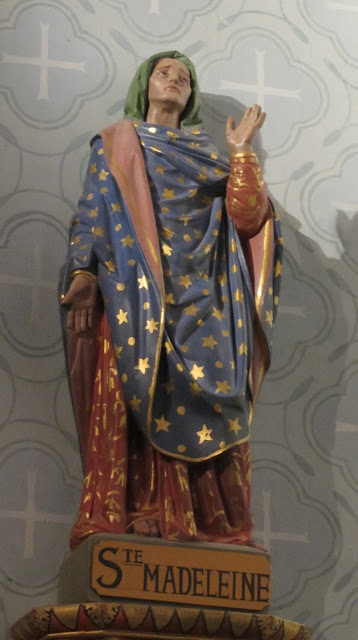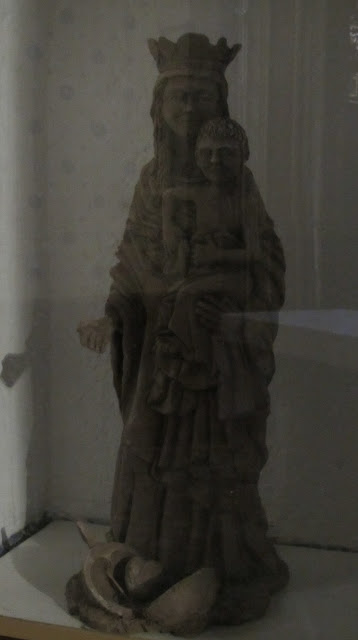Today we went off to explore Limoux a little more on foot.
Walking to the Basilica of Our Lady of Marceille a church in Southern Gothic ( XIVth and XV th centuries) style dedicated to Mary.Registered as a historic monument since 1948.
The occupation of the area is ancient it has tools discovered that are of the Middle Palaeolithic , oven, well preserved, the Vérazien ( Neolithic , III thmillennium BC. ). Also objects of the age Of bronze .
The church appears in the texts in 1011 associated with the villa of Flassian, and more definitely in 1137 . The Black Madonna, wooden statue which is venerated in the sanctuary is dated XI th century . The construction of the current building was undertaken at the beginning of XIV th century, its plan has a single nave. Until the 17th century , the task of welcoming pilgrims was left to hermits. However, François Fouquet , when he was appointed archbishop of Narbonne, thought of entrusting the Doctrinaires with the conduct of a seminary and a house of missionaries; he obtained from the consuls of Limoux to install them at Notre-Dame de Marceille. This change was carried out by his successor, Pierre de Bonzi, in 1674, when he placed two priests of the Christian doctrine in charge of receiving pilgrims and ecclesiastics in spiritual retreat.
This squirrel welcomed us as we walked up the path to the well as we approached the church.
Walking to the Basilica of Our Lady of Marceille a church in Southern Gothic ( XIVth and XV th centuries) style dedicated to Mary.Registered as a historic monument since 1948.
The occupation of the area is ancient it has tools discovered that are of the Middle Palaeolithic , oven, well preserved, the Vérazien ( Neolithic , III thmillennium BC. ). Also objects of the age Of bronze .
The church appears in the texts in 1011 associated with the villa of Flassian, and more definitely in 1137 . The Black Madonna, wooden statue which is venerated in the sanctuary is dated XI th century . The construction of the current building was undertaken at the beginning of XIV th century, its plan has a single nave. Until the 17th century , the task of welcoming pilgrims was left to hermits. However, François Fouquet , when he was appointed archbishop of Narbonne, thought of entrusting the Doctrinaires with the conduct of a seminary and a house of missionaries; he obtained from the consuls of Limoux to install them at Notre-Dame de Marceille. This change was carried out by his successor, Pierre de Bonzi, in 1674, when he placed two priests of the Christian doctrine in charge of receiving pilgrims and ecclesiastics in spiritual retreat.
This squirrel welcomed us as we walked up the path to the well as we approached the church.
A miraculous spring is located down the path to the side of the church. It is visited by pilgrimages in September. Here the waters are reported to heal especially eye complaints so I stood in the waters which were very cold for a few minutes, may I be blessed with healing of my eyes or blessings on the surgery that I will have.
This statue is in a niche above the waters of the shrine.
Out the front of the church in the grounds this statue can be found with another behind further into the park of Saint Vincent de Paul.
Just opposite the front door of the church is this statue of Anne and Mary.
The entrance to the building is from the south, in the middle of the nave completed in 1488 (and restored in 1863 ), is a statue of the Mother, child and two angels.
The church was elevated to the rank of minor basilica on 5 February 1905. In October 2007, while the church was under construction, the Black Madonna was decapitated, her head and coat were stolen. She displays some remarkable details. The most striking aspect is Her face, with an enigmatic smile and eyes that are wide open, with dark pupils; they seem to look right at you! According to an old inscription, it stated that he “who sees the statue smiling at him, is certain to obtain the grace which he came to beseech”.
Another mystery about Her is the symbolic layers of meaning, although She is black, the child Jesus is not being white. One theory is that this difference expresses how the Black Madonna – whose darkness symbolizes the obscure, the underground – was the source of a light, solar child. Darkness gives birth to light. This is a well-known pagan symbol that is found in various places where gods or goddesses were believed to have been born in a cave. Or in megalithic passage tombs, such as Newgrange in Ireland, where the sun penetrates the darkness on the winter solstice, the longest night of the year. With the presence of an ancient megalithic complex on this site, perhaps the light and dark of the two elements of the statue is a subtle hint of that same message.
The church of Notre-Dame de Marceille is typical of the southern Gothic style: it has only one nave with five bays. Initially covered with a framework resting on diaphragm arches, it was vaulted in 1783 . Two chapels of square planes open in the first bay, the one on the left sheltering the Black Madonna; It also contains a picture painted in 1689, offered in ex voto following the fire that ravaged Limoux in September 1685.
We left the church and walked back into town stopping at the Railway Station Restaurant for lunch and then walking on to see the Eglise de L’Assumption.
The Eglise de L’Assumption was built in the late 19th century and has a particular style that gives it a different look and charm. The church houses a statue of the Lady of the Rosary dating back more than 750 years. The façade was restored in 2008 during the 19th edition of Toques and Clochers which took place on 15th March and the auction of the Chardonnay oak barrels on 16th March.
There were no remarkable stain glass windows around the walls as in other churches however in the roof over the altar was this amazing window with the most extraordinary woodwork recess to hold the window. The photos do not show just how beautiful this was.
Just a few 100mtrs away was the Musee of Automates, in this museum of such a difference you discover more than one hundred automatons "a mechanical pantomime, in a series of scenes where characters inspired by tales and myths, from the Venetian carnival to the other phantasmagoras" come to life. At the end you can even visit the creative workshop. Such an amazing work now run by the daughter and son in law of the creators.




















































































